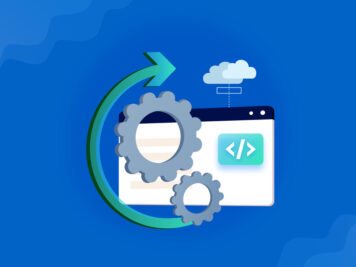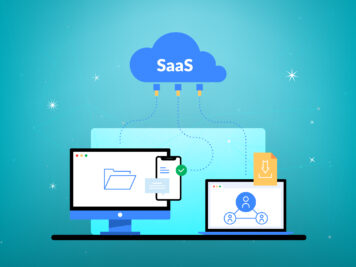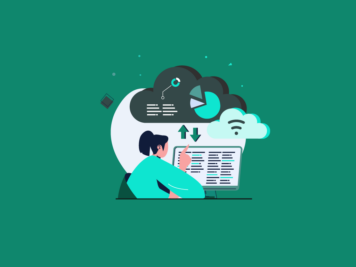The competitive nature of the SaaS industry isn’t driven solely by its revenue potential. Its asset-light nature, collaborative features, and extensibility and elasticity have made it a coveted option across industries. SaaS can be transformative for startups. In an ecosystem where 90% of startups fail, SaaS MVP development could be a game-changer. CB Insights has highlighted a lack of market demand as a leading reason for startup failures. A SaaS MVP lowers costs and is scalable. Benefits like these make it an ideal option for testing product readiness.
Developing an MVP for your SaaS product is critical to determining whether it resonates with your target audience and your business model is sustainable. A well-executed SaaS MVP allows you to test core features, gain meaningful user insights, and iterate on real-world data. This technique eliminates risk and increases the likelihood of long-term success.
This blog post offers a comprehensive approach to a complete guide to SaaS MVP development. It covers everything from identifying your target market and designing an intuitive UI and UX to selecting the optimal technology stack, deploying and testing your MVP, and evaluating its effectiveness. I will also go over the average development timeline, factors that affect SaaS MVP development costs, case studies, and how to choose the right SaaS MVP development partner to make your SaaS vision a reality.
What is a SaaS MVP?
A SaaS minimum viable product (MVP) is the most basic version of your software, intended to test the core concept of your product and gather valuable customer insights.
It focuses on delivering vital features that solve a critical problem for your target audience, allowing you to assess market demand and adjust your product strategy without making a significant upfront investment. This technique saves time and resources on features that may not appeal to users.
The growing SaaS market
The SaaS market remained geographically diverse in 2024, with North America accounting for nearly 50% of the total share, which amounted to $135 billion generated in 2023. The U.S. SaaS industry alone will grow significantly, reaching a valuation of $236.69 billion by 2032.
This growth, coupled with increasing global investment and rising demand for AI-powered SaaS, has resulted in a highly competitive market. To survive in this climate, a strategic approach to software development for startups is essential, and SaaS MVP development provides that.
A well-executed SaaS MVP offers several advantages:
Key benefits of SaaS MVP development
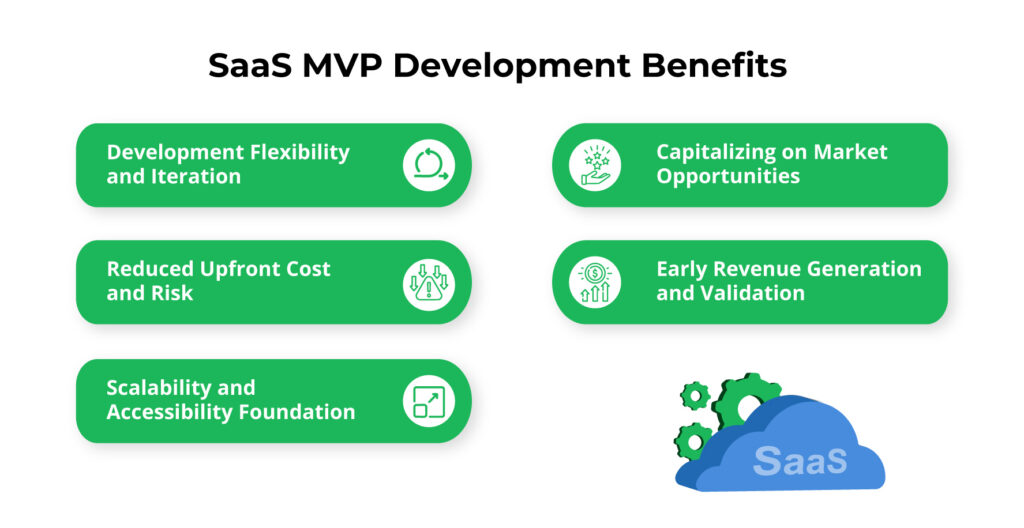
- Development flexibility and iteration: A simplified MVP allows you to iterate and pivot based on real-world user feedback and changing market demands. This iterative approach is critical to building a product that meets your customers’ needs.
- Reduced upfront cost and risk: Creating a minimal version of your product significantly reduces your initial development costs. This allows you to test your SaaS concept without taking on considerable financial risk, making it ideal for startups and bootstrapped businesses.
- Scalability and accessibility foundation: While the MVP focuses on basic functionality, it is critical to plan for scalability and accessibility from the start. Building a solid foundation ensures that your product can develop and reach a wider audience as it scales.
- Capitalizing on market opportunities: By launching an MVP, you can quickly enter the market and take advantage of growing opportunities. You can gain a competitive advantage by prioritizing important features and reducing time to market.
- Early revenue generation and validation: A SaaS MVP can generate money early, even at its introductory stage. This initial cash flow can provide financial assistance, validate your monetization plan, and show the product’s market potential.
- Access to specialized expertise: Startups often lack a full in-house team, making access to tech experts crucial. Developing a SaaS MVP allows you to collaborate with experienced developers, designers, and other tech professionals, gaining valuable insights and accelerating development without the overhead of full-time hires.
5 stages of SaaS MVP development
Every product development process starts with a series of core steps that must be completed. SaaS MVPs are no exception. Here are the five essential stages of SaaS MVP development, ensuring you create a product that resonates with your target audience and positions you for success.
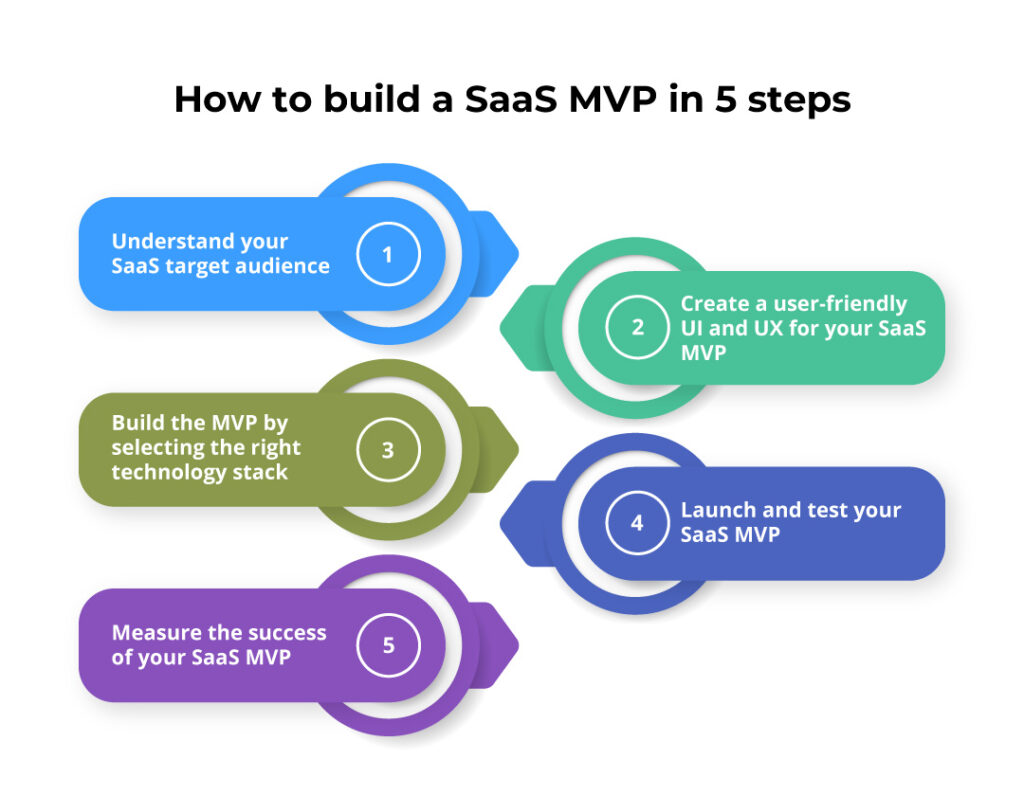
Understanding your SaaS target audience
Before you start developing a SaaS MVP, it is crucial to first identify your target audience. This includes conducting thorough market research to determine the profile of your target consumer. Who are they? What are their demographics, hobbies, and behaviors? And most importantly, what are their requirements, wants, and pain points?
Key questions for market research:
- What industries do your potential SaaS consumers belong to?
- What is their age, location, and job title?
- What obstacles do they face in their regular operations? What difficulties are they trying to solve?
- What drives them to seek a SaaS solution? What are the desired outcomes?
You can tailor your SaaS MVP to meet your audience’s requirements and deliver a valuable solution by answering these questions. This targeted approach is critical to attracting early users and gathering helpful feedback.
Creating a user-friendly UI and UX for your SaaS MVP
Once you thoroughly understand your target audience, the next crucial stage is to create an intuitive and engaging user interface (UI) and user experience (UX) for your SaaS MVP. This is when prototyping and user feedback become essential.
Prototyping allows you to visualize and test different interface ideas and user processes before moving them into production. This iterative technique lets you develop your ideas quickly and gain valuable insights. Interactive prototyping allows you to experiment with different navigation options, button placements, and overall layouts, providing a smooth user experience.
Gathering feedback throughout the development process is critical for identifying areas for improvement, whether it comes from potential users, stakeholders, or usability testing. This continuous feedback loop ensures that the final product reaches your target audience and meets their needs. A user-centered design drives adoption and engagement with your SaaS MVP.
Simplicity and intuitiveness are the keys to a great SaaS MVP UI/UX. This involves:
- Straightforward Navigation: Implement intuitive navigation menus and clear paths to guide users through the app.
- Compelling Calls to Action: Use strategically placed and visually distinctive call-to-action buttons to encourage user interaction and desired actions.
- Visually Appealing Layouts: Create clean, uncluttered layouts that are pleasing to the eye and enhance usability.
A good UI/UX is more than just about aesthetics—it’s about creating a product that people find helpful and easy to use. By focusing on these best practices, you can make a SaaS MVP that appeals to early users and lays the groundwork for future expansion. You can move on to the development stage once the UI/UX design is complete.
Building the MVP by selecting the right technology stack
Choosing the right technology stack for your SaaS MVP requires balancing functionality, development speed, and future scalability. Over-engineering at this level can be costly and time-consuming, so you should select tools and frameworks appropriate for your project’s goals and long-term ambitions.
- Choice of programming languages: The programming language you choose will determine the flexibility and efficiency of your MVP. JavaScript is fantastic for creating dynamic user interfaces, while Python’s simplicity makes it an excellent choice for rapid development. Java is a reliable and scalable option for large-scale applications, while Ruby offers a developer-friendly environment.
- Building the front end: The user interface is critical to delivering a seamless experience to users. React offers a component-based framework for a modular approach to development, while Angular provides a comprehensive set of tools for large projects. Vue.js stands out for its simplicity and ease of use.
- Choosing a back-end framework: Stability and performance are critical since the back-end handles server-side data and functions. Node.js is known for its performance and ability to handle multiple simultaneous requests, but Django offers a fully featured framework for rapid development. These frameworks will provide a robust and scalable back end for your SaaS MVP.
- Database management: Right database can ensure smooth operation and growth. PostgreSQL excels at handling complex queries and reliability, while MongoDB offers flexibility and scalability. MySQL, however, is a fast and easy alternative for efficiently managing large amounts of data.
- Cloud platforms for scalability: Cloud platforms offer the infrastructure needed to deploy, grow, and manage your MVP. AWS is known for its global reach and innovative services like AWS Lambda, while Google Cloud Platform is highly valued for its analytics and machine learning capabilities. Microsoft Azure offers seamless interaction with Microsoft products as well as broad support for enterprise environments. Choosing the right cloud provider makes your MVP scalable, cost-effective, and secure.
- DevOps tools for efficient development: DevOps tools like Jenkins, Kubernetes, and Docker can significantly increase the efficiency of your development cycle. Jenkins automates builds and integrations, Kubernetes optimizes container orchestration, and Docker enables portability through containerization. These technologies improve collaboration, speed up development cycles, and ensure high-quality releases—all of which are crucial to the long-term success of your SaaS MVP.
Essential aspects to consider when choosing an MVP technology stack
- Development speed: How quickly can you build and iterate the MVP using this technology?
- Developer’s familiarity: Have you or your team worked with these technologies?
- Community support: Is there a strong community and adequate documentation?
- Cost: Think about the cost of licensing, hosting, and other resources.
- Future scalability (considerations): While not the primary goal of an MVP, select technologies that will not cause severe bottlenecks in the future.
Note: Avoid selecting technologies because they are trendy or have fancy features that your MVP doesn’t require. Keep things simple and focus on delivering core value.
Launching and testing your SaaS MVP
A successful launch of SaaS MVP requires strategic planning and continuous development. This stage is essential to gather real-world data and confirm your hypotheses.
Pre-launch preparations
Before the launch, you must develop robust analytics and tracking systems. These technologies provide essential insights into user behavior, engagement, and overall product performance. Tracking important metrics allows you to understand how users interact with your MVP and identify areas for improvement.
Analytics tools for SaaS MVPs:
Using the right analytics tools is critical to making data-driven decisions. Consider implementing the following:
- Google Analytics is a robust and frequently used software for analyzing website traffic, user demographics, and conversion rates. (It’s good for SEO due to its prevalence and available resources.)
- Mixpanel focuses on user behavior analysis to analyze specific actions within your app and better understand user journeys. (It’s suitable for understanding user engagement.)
- Amplitude is another powerful product analytics tool that provides detailed insights into user behavior and product usage trends. (Great for product-focused metrics.)
These tools help you collect meaningful data for product development and improving the effectiveness of the MVP.\
Post-launch
Once your SaaS MVP is live, you should focus on getting feedback from your early users. This feedback loop is critical to understanding users’ wants, preferences, and pain points. Use a multifaceted strategy to gain relevant insights.
- In-App Messaging: Use in-app surveys or feedback messages to gather real-time feedback on the user experience. (Great for targeted feedback)
- Feedback Forms: Provide targeted feedback forms on your website or within the app where users can provide specific feedback and ideas. (Great for organized feedback)
- User Surveys: Conduct targeted surveys to gather specific data on user satisfaction, feature usage, and overall experience. (Great for quantitative data)
- Social Media Monitoring: Actively monitor social media channels for mentions of your product and engage with people to gather feedback and resolve issues. (Great for public opinion analysis)
By actively soliciting and evaluating user feedback, you can identify areas for development, prioritize improvements, and fine-tune your SaaS MVP to fit market demand. This iterative process is central to the MVP methodology and lays the foundation for developing a successful SaaS solution.
Measuring the success of your SaaS MVP
Just launching the MVP is not sufficient. You must evaluate its success and monitor key performance indicators to ensure your MVP is performing as expected and providing valuable insights for refinements to meet your company’s goals.
Start by defining the right KPIs to track the performance of your MVP. Clear and accurate KPIs will allow you to set success criteria and track your progress over time.
Some examples of SaaS MVP KPIs are:
- Customer Acquisition Cost (CAC) – What is the cost of acquiring a new customer?
- Monthly Recurring Revenue (MRR)- How much predictable monthly revenue are you earning?
- Churn Rate- What percentage of consumers are abandoning their subscriptions within a period?
- Customer Lifetime Value (CLTV) – What is the estimated total revenue a customer will generate when connecting with your company?
- Trial-to-Paid Conversion Rate – What percentage of trial users convert to paying customers?
User engagement is critical to the long-term success of your SaaS MVP. To understand how people interact with your product, track the following metrics:
- Daily and monthly active users (DAU/MAU): How many consumers are using your product daily or weekly?
- Average session duration: How long do people stay in your app each session?
- Feature usage: What are the most and least used features? This helps prioritize future development.
- User retention rate: How well do you retain users over time?
Ultimately, the goal of your SaaS MVP is to convert consumers into paying customers —track conversion rates at each stage of the customer journey.
- Visit the website to sign up – How many website visitors create accounts?
- Sign-up to trial: How many registered users start a trial?
- Trial to paid subscription conversion – How many trial users become paying subscribers?
Analyzing conversion rates allows you to uncover bottlenecks in your sales funnel and adjust your operations for optimal efficiency. Performing A/B testing in different ways can help you improve your conversion strategy.
Building your own MVP becomes even easier when you know the right steps. To have a look over what each step involves you can access ours 8-step minimum viable product checklist developing a successful startup product.

How much does a SaaS MVP cost?
No one can accurately estimate how much your MVP will cost. Several factors always determine its cost. However, taking these factors into account will help you plan your budget.
This section explains the key cost factors for SaaS MVP development.
Team structure and location
The team structure and location of your development team have a major impact on the overall cost. Here’s an overview of the most common options:
In–house team:
Building an in-house team provides direct control and increased communication. However, it involves more overhead, such as salary, benefits, office space, and equipment. Due to the high initial expense, this is not typically recommended for SaaS MVP development.
Outsourcing:
Hiring a specialist development team or agency can be more cost-effective, particularly for MVPs. You gain access to experts without making the long-term commitment of hiring full-time staff. You can also consider outsourcing a CTO if you already have a team in place. Location is key here; outsourcing to locations with lower labor costs (e.g., India) can significantly reduce costs.
Freelancers:
Hiring individual freelancers can be a flexible solution for specialist work or smaller projects. However, managing multiple freelancers can be time-consuming and requires excellent project management skills.
SaaS MVP complexity
The complexity of your SaaS MVP has a direct influence on development time and costs. Key factors include:
Core features:
The number and complexity of core features majorly impact the development effort. A simple MVP with minimal features will inevitably be less expensive than one with complex features.
Integrations:
Integrating with third-party services (e.g., payment gateways, CRM systems) can increase complexity and expense, particularly if specific integrations are needed. Consider leveraging publicly available APIs and pre-built integrations whenever possible.
Custom design vs. templates:
Using pre-built templates can shorten design and development times, reducing costs. Custom designs provide better branding and versatility but require additional resources.
The more complex the platform, the more time and resources it needs to develop and the higher its price.
Technology stack and infrastructure
The technology stack you choose for your SaaS MVP, including programming languages, frameworks, databases, and hosting infrastructure, substantially impacts development costs, performance, scalability, and maintainability. Making smart decisions in this regard is critical to maximizing your dollars and ensuring the success of your MVP.
Programming languages and frameworks:
Market demand and developer availability vary by programming language and framework. Languages with large, active communities, such as Python and JavaScript, typically have a larger pool of developers, which can result in more competitive pricing. In contrast, less widespread or highly specialized languages may require hiring more expensive specialists.
The right framework can significantly speed development by including pre-built components, tools, and best practices. Frameworks with rapid development capabilities include Ruby on Rails, Django (Python), and Node.js (JavaScript). This can lead to cheaper development costs and a shorter time to market.
The language and framework you choose also influence your application’s long-term maintainability and scalability. Choosing a well-established and widely supported technology reduces the likelihood of facing compatibility issues or problems hiring developers for future maintenance and scaling.
Examples:
Front-end: JavaScript (React, Angular, Vue.js), HTML and CSS.
Back-end: Python (Django, Flask), Ruby on Rails, Node.js, Java and .NET.
Mobile (if applicable): Swift (iOS), Kotlin (Android), React Native and Flutter.
Cloud hosting:
Cloud hosting companies (such as AWS, Google Cloud Platform, and Azure) offer a variety of pricing options, including pay-as-you-go, reserved instances, and spot instances. Choosing the right pricing model and scaling your resources based on demand can help you save costs dramatically.
Database solutions:
The decision between SQL (relational) and NoSQL databases depends on the data structure and application needs. SQL databases (such as MySQL and PostgreSQL) are best suited for structured data and complicated connections. In contrast, NoSQL databases (such as MongoDB and Cassandra) are better for unstructured data and have high scalability requirements.
SaaS type and industry regulations
The type of SaaS application you are building, as well as the industry you serve, can have a substantial influence on development costs due to different legal and security requirements.
Industry-specific requirements
Certain companies have strict requirements that SaaS applications must meet. These requirements often require specialized security measures, data handling protocols, and compliance certifications, which can increase development complexity and costs.
Some examples include:
- Healthcare (HIPAA): SaaS solutions that handle protected health information (PHI) must comply with the Health Insurance Portability and Accountability Act (HIPAA), which requires strict security measures and precise data handling standards.
- Finance (PCI DSS, GDPR): SaaS applications that process credit card transactions must comply with the Payment Card Industry Data Security Standard (PCI DSS). Additionally, European regulations such as the General Data Protection Regulation (GDPR) set strict data protection standards.
- Government (FedRAMP): SaaS solutions for U.S. government entities must often comply with the Federal Risk and Authorization Management Program (FedRAMP).
Data security and privacy:
Regardless of industry standards, all SaaS applications should place an emphasis on data security and user privacy. Implementing strong security measures, such as encryption, access restrictions, and frequent security audits, is critical and can increase development costs.
Complexity of the SaaS type:
The type of SaaS software used also determines the cost. For example:
- CRM (customer relationship management) solutions can involve complicated data modeling, interaction with other business tools, and powerful reporting capabilities.
- ERP (enterprise resource planning) systems are often complicated, requiring multiple modules, interfaces with other departments, and extensive customization.
- SaaS products (such as a simple scheduling or note-taking app) will typically be less sophisticated and, therefore less expensive to build.
Estimate your SaaS MVP budget
While determining an exact cost is impossible without accurate project information, recognizing these criteria will help you collaborate with a development team to establish a reasonable estimate. Request specific quotes from multiple vendors to compare prices and services. Remember that focusing on the essential functionality of your MVP is critical to keeping expenses low and quickly demonstrating your core business idea.
Average time to develop an MVP for SaaS
One of the most frequently asked questions by startups and entrepreneurs entering the SaaS space is, “How long does it take to build a SaaS MVP?” While there is no one-size-fits-all solution, the typical development duration for a SaaS Minimum Viable Product (MVP) ranges from 3-6 months.
This timeframe varies, but focused development, the right team, and the right technology stack are critical to achieving a faster time- to- market.
Real-world examples of rapid SaaS MVP development
Here are some examples of how streamlined development leads to faster MVP deployments and better business outcomes:
Building a new product with an extended team
A well-known digital financial platform wanted to introduce a new product quickly to take advantage of the market demand. They had a tight timeline and limited internal resources. So, they collaborated with us to streamline the process and fill skill gaps with our experienced engineers. We helped them successfully launch their MVP in less than 5 months by focusing on core features and fostering smooth cooperation.
Read the full success story here!
Idea to MVP in 120 days
A risk management startup was aiming to simplify decision-making for B2B executives. After carefully confirming their core idea with early customers, they set an ambitious goal of deploying their MVP within 120 days (4 months).
To enter the market rapidly, the startup partnered with us. We helped them succeed by focusing on the core features that were most important to them. Our experienced developers created a scalable architecture, reduced development time, and provided a seamless product lifecycle from start to finish. The result was a successful launch within the specified timeframe, with 5 paying B2B customers acquired in the first month and funding secured from reputable investors.
Read the full success story here!
How to choose the right MVP software development company/partner
Choosing the right software product development company/ partner is critical to the success of your SaaS MVP. A talented and experienced team can efficiently and effectively bring your idea to life, but the wrong choice can lead to delays, cost overruns, and a mediocre product. Here are some crucial variables to consider:
Evaluate the partner’s capabilities
Technical expertise: Technical expertise is the foundation of effective SaaS MVP development. The partner you choose should have a deep understanding of the applicable technologies and the ability to successfully use them. For example, building a custom financial SaaS application may require blockchain, cybersecurity, artificial intelligence (AI), and data analytics skills.
Choosing a one-stop solution provider has significant advantages, including seamless adaptation to changing demands. While you may not need AI integration right away, collaborating with a team capable of integrating AI/ML in the future ensures that your product can evolve without significant disruptions or costly overhauls.
Industry knowledge: It is also essential when choosing a SaaS MVP development partner. A partner with proven experience in your industry provides critical insights and recommendations that are consistent with best practices.
This knowledge of industry-specific challenges and opportunities can greatly speed up the development process and improve the market fit of the final product. Their experience can help anticipate potential barriers and ensure compliance with applicable industry standards.
Talent pool: The talent pool of your development partner directly influences the quality and speed of your SaaS MVP development. While attractive low-cost alternatives may seem appealing, it is critical to emphasize the quality of talent.
Putting talent at risk can have costly consequences down the road, such as project delays, additional revisions, and, ultimately, a poor product. Balancing cost-effectiveness with access to a skilled team of developers, designers, and engineers is critical to mitigating risks and achieving a successful SaaS MVP launch.
Project management methodology: Effective project management is critical to keeping your SaaS MVP project on schedule and budget. Look for a partner with strong project management skills and a track record of delivering successful projects.
A skilled project manager will ensure clear communication, proactive problem resolution, and effective resource allocation, resulting in a smooth and successful project outcome for your SaaS MVP.
Evaluate cultural fit and collaborations
Communication and collaboration: Effective communication and teamwork are critical to successfully developing a SaaS MVP. The partner you choose should be skilled in both synchronous and asynchronous communication. Synchronous approaches facilitate quick decision-making and problem-solving, while asynchronous communication allows team members to analyze information and respond at their own pace.
A balanced approach improves workflow, reduces superfluous back-and-forth communication, and fosters more efficient and effective teamwork. Streamlining communication is critical in SaaS MVP development to increase productivity, reduce delays, and stay focused on key activities. Clear and concise communication helps avoid misunderstandings, prevents unnecessary back-and-forth, and saves time—all of which contributes to more significant alignment and on-time project delivery.
Shared vision: A shared vision between your company and your development partner is critical to synchronizing goals and ensuring project success. Ensure the partner is fully aware of your project goals, expected outcomes, and overall company strategy.
In today’s changing market, a forward-thinking strategy is essential. Look for partners who keep up with industry trends, value innovation, and are open to exploring new ideas and technologies that will benefit your SaaS MVP. This shared understanding of the long-term vision ensures that development efforts are continually focused on achieving your business goals.
Customer focus: SaaS MVP development partner should focus more on outcomes than output. While delivering features and functionality that meet specifications is critical, the real, measurable economic benefits gained from the product are what truly determine success.
A results-oriented partner focuses on user experience, business development, and operational efficiency, ensuring that the solution produced successfully addresses real-world challenges and generates demonstrable business value. Look for a partner with a proven track record of providing practical solutions that match customer goals, indicating their dedication to achieving your company’s objectives.
Consider pricing and engagement models
- Budget alignment: Discuss your budget openly and ensure the partner’s pricing model fits within your financial constraints.
- Engagement model: Determine whether a fixed-price, time-and-materials model, or a dedicated team model best fits your project. Consider factors such as project scope, risk, and team competencies.
Conduct thorough due diligence
Portfolio review: A thorough portfolio assessment provides insights into a potential partner’s capabilities and past success. Examine their past projects, paying particular attention to products comparable to your SaaS MVP.
This review allows you to examine their experience and competence in key areas, ensuring they have the skills to meet your project’s goals. A strong portfolio illustrates a partner’s ability to deliver concrete results and their expertise in custom SaaS development.
Customer references: Ask for references from past clients to gain in-depth insights into their experiences. Hearing directly from past clients gives you essential context about your partner’s reliability, quality of work, and responsiveness, allowing you to make an informed decision.
Company culture: Evaluate the partner’s company culture to ensure it is consistent with your values and work style. A good cultural fit promotes better collaborations, improves communication, and results in a more effective relationship.
By carefully considering these aspects and conducting thorough research, you can improve your chances of finding the right development partner to bring your SaaS MVP idea to life.
Conclusion
At Talentica, we don’t deliberate; we deliver. From building MVPs in 90 days to managing 50 billion views per day, our focus is on excellence in execution. We hire only the best talent from top institutions like IITs, NITs, and BITS because solving complex problems requires the brightest minds. For a fast and efficient SaaS MVP development solution, contact us today.
